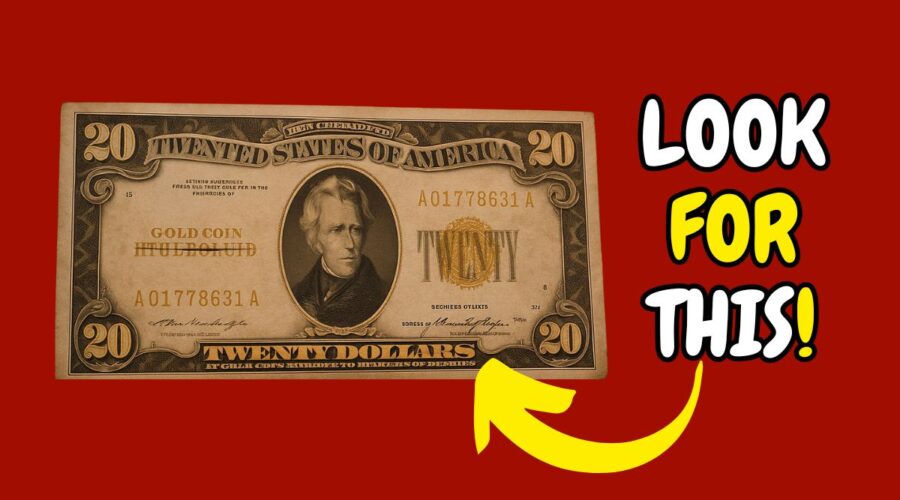1928 $20 Gold Certificate Sells for $670,000, a Stunning Auction Highlight
A rare 1928 $20 Gold Certificate recently shattered expectations at a high-stakes auction, clinching an astonishing $670,000. What makes this near-century-old banknote so valuable?
In this in-depth exploration, we unpack the historical context, auction dynamics, condition details, and investment perspective behind this extraordinary sale.
What Is a Gold Certificate?
- Gold Certificates were a form of U.S. paper currency that could be exchanged for actual gold coins, issued up until the Gold Recall of 1933.
- These notes prominently feature a bold orange “GOLD” seal, symbolizing their direct link to the U.S. gold reserve.
- They became illegal to own privately after President Franklin D. Roosevelt’s Executive Order 6102 in 1933, which aimed to stabilize currency during the Great Depression.
- In 1964, Gold Certificates were once again legal to collect, but their redemption for bullion had long since expired.
Historical Background – A Glimpse of 1920s America
Issued in 1928, this note represents the twilight of gold-backed U.S. currency. At that time, the U.S. still operated on the Gold Standard, backing paper money with physical gold reserves.
By 1933, the government seized gold assets to combat widespread bank failures. Most surviving Gold Certificates were withdrawn and destroyed, making pristine examples exceedingly rare.
Why This Certificate Sold for a Massive $670,000
The remarkable price stems from a blend of rarity, condition, historical signatures, and intense collector interest:
- Gem Uncirculated Grade: Experts confirmed the note was graded “Gem Uncirculated”, showing pristine color and texture, clear margins, and no folds or marks – a near impossible state for a currency note nearly 100 years old.
- Signature Pairing: It bears the signatures of Treasurer W.A. Julian and Secretary Andrew W. Mellon, both historically significant figures in U.S. economic policy.
- Low Survivorship: Only a handful of 1928 $20 Gold Certificates in such condition exist, with the government destroying the rest during the 1933 recall.
- Auction Frenzy: Bidding surpassed expectations (initially estimated between $250,000–$400,000) when wealthy collectors entered fierce fray, driving the final price to $670,000.
Auction Snapshot
| Detail | Information |
|---|---|
| Auction Date | Early June 2025 |
| Final Hammer Price | $670,000 |
| Initial Estimates | $250,000 – $400,000 |
| Grading | Gem Uncirculated |
| Signatures | W.A. Julian, A.W. Mellon |
| Rarity Factor | Exceptionally high due to government recall |
| Condition Highlights | Crisp embossing, perfect margins, vibrant color |
Condition: Why It Matters
The note’s condition was pivotal. A Gem Uncirculated grade translates to virtually flawless physical integrity – a rare find for nearly century-old currency.
Collectors prioritize features like crisp embossing, no folds, balance in print and color, and undamaged seals, all present in this piece.
The Role of Scarcity in Valuation
- Low Survival Rate: Following the 1933 gold recall, the majority of gold-backed notes were removed and destroyed. The few remaining notes became collector’s treasures.
- Signature and Series Rarity: The combination of the 1928 series, signature pairing, and perfect grade positions this note at the apex of value.
- Collector Demand: Wealthy investors view such pieces as both piece of history and investment treasures—often winning auctions with high bids.
Value Spectrum of 1928 Gold Certificates
| Condition Grade | Estimated Value |
|---|---|
| Very Fine (circulated) | $250 – $500 |
| Choice Uncirculated | $750 – $1,500 |
| Gem Uncirculated | $10,000 – $100,000+ |
| This Specimen (Gem) | $670,000 |
Note: Selection above is illustrative; actual market prices reflect intense variation based on condition and provenance.
Broader Auction Context
Gold Certificates from other years, like 1863 and 1928 high-denomination ($500, $1,000) versions, still command six-figure sums—but rare examples in Gem grade are especially prized.
This particular 1928 $20 example now ranks as one of the most valuable known.
Investment Potential – Should You Chase Gold Certificates?
- Pros: Tangible asset, historical appeal, strong value retention, and potential appreciation.
- Cons: Requires specialized storage, third-party grading, authentication, and understanding nuanced market factors.
- Advice: Seek certified notes (PMG, PCGS), verify signatures, and study census data (survivorship by signature, grade).
What Sets This Gold Certificate Apart
- Tiger-Grade Condition: Impeccable state preserved over nearly 100 years.
- Historic Signatures: Julian and Mellon, tying the note directly to a pivotal era in U.S. economic history.
- Untapped Provenance: Auction documents confirmed authenticity via detailed grading review and certification.
- Collector Psychology: Rare, museum-worthy notes always spark intense bidding wars.
The $670,000 sale of this 1928 $20 Gold Certificate proves that rare, well-preserved artifacts from America’s gold-backed monetary era are not just relics—they’re sky‑high investments. As tangible representations of economic evolution, they invite both admiration and financial interest.
Whether you’re a collector or investor, surviving gold-note treasures like this one offer a unique bridge between history and wealth.
The auction success of the 1928 $20 Gold Certificate for $670,000 proves that rare currency can transcend face value to become highly prized collectibles. As interest in historical monetary artifacts grows, so does the allure—and potential investment—of these golden pieces of history.
FAQs
Can I still own a Gold Certificate today?
Yes. Since 1964, it has been entirely legal to own old Gold Certificates as collectibles. However, you cannot redeem them for gold.
What factors influence the value of a 1928 $20 Gold Certificate?
Key drivers include: grade/condition, signature pairing, series year, provenance, and market demand.
How can I find out if my note is worth something?
Look for grading certification (PMG, PCGS), check series and signatures, survey auction results, and consult professional graders or dealers.


Leave a Reply